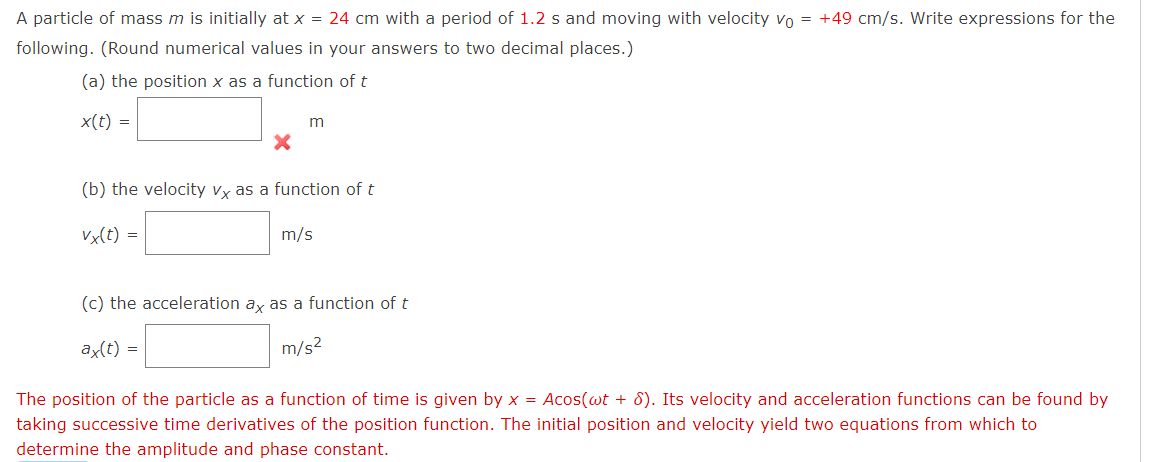A particle of mass m is initially at x = 24 cm with a period of 1.2 s and moving with velocity vo = +49 cm/s. Write expressions for the following. (Round numerical values in your answers to two decimal places.) (a) the position x as a function of t x(t) = m (b) the velocity vy as a function of t Vx(t) = m/s (c) the acceleration ay as a function of t ax(t) = m/s? The position of the particle as a function of time is given by x = Acos(wt + 8). Its velocity and acceleration functions can be found by taking successive time derivatives of the position function. The initial position and velocity yield two equations from which to determine the amplitude and phase constant.
A particle of mass m is initially at x = 24 cm with a period of 1.2 s and moving with velocity vo = +49 cm/s. Write expressions for the following. (Round numerical values in your answers to two decimal places.) (a) the position x as a function of t x(t) = m (b) the velocity vy as a function of t Vx(t) = m/s (c) the acceleration ay as a function of t ax(t) = m/s? The position of the particle as a function of time is given by x = Acos(wt + 8). Its velocity and acceleration functions can be found by taking successive time derivatives of the position function. The initial position and velocity yield two equations from which to determine the amplitude and phase constant.
Physics for Scientists and Engineers: Foundations and Connections
1st Edition
ISBN:9781133939146
Author:Katz, Debora M.
Publisher:Katz, Debora M.
Chapter1: Getting Started
Section: Chapter Questions
Problem 37PQ
Related questions
Concept explainers
Question
The position of the particle as a function of time is given by x = Acos(?t + ?). Its velocity and acceleration functions can be found by taking successive time derivatives of the position function. The initial position and velocity yield two equations from which to determine the amplitude and phase constant.

Transcribed Image Text:A particle of mass m is initially at x = 24 cm with a period of 1.2 s and moving with velocity vo = +49 cm/s. Write expressions for the
following. (Round numerical values in your answers to two decimal places.)
(a) the position x as a function of t
x(t) =
m
(b) the velocity vy as a function of t
Vx(t) =
m/s
(c) the acceleration ay as a function of t
ax(t) =
m/s?
The position of the particle as a function of time is given by x = Acos(wt + 8). Its velocity and acceleration functions can be found by
taking successive time derivatives of the position function. The initial position and velocity yield two equations from which to
determine the amplitude and phase constant.
Expert Solution
This question has been solved!
Explore an expertly crafted, step-by-step solution for a thorough understanding of key concepts.
Step by step
Solved in 2 steps with 4 images

Knowledge Booster
Learn more about
Need a deep-dive on the concept behind this application? Look no further. Learn more about this topic, physics and related others by exploring similar questions and additional content below.Recommended textbooks for you

Physics for Scientists and Engineers: Foundations…
Physics
ISBN:
9781133939146
Author:
Katz, Debora M.
Publisher:
Cengage Learning

Physics for Scientists and Engineers: Foundations…
Physics
ISBN:
9781133939146
Author:
Katz, Debora M.
Publisher:
Cengage Learning